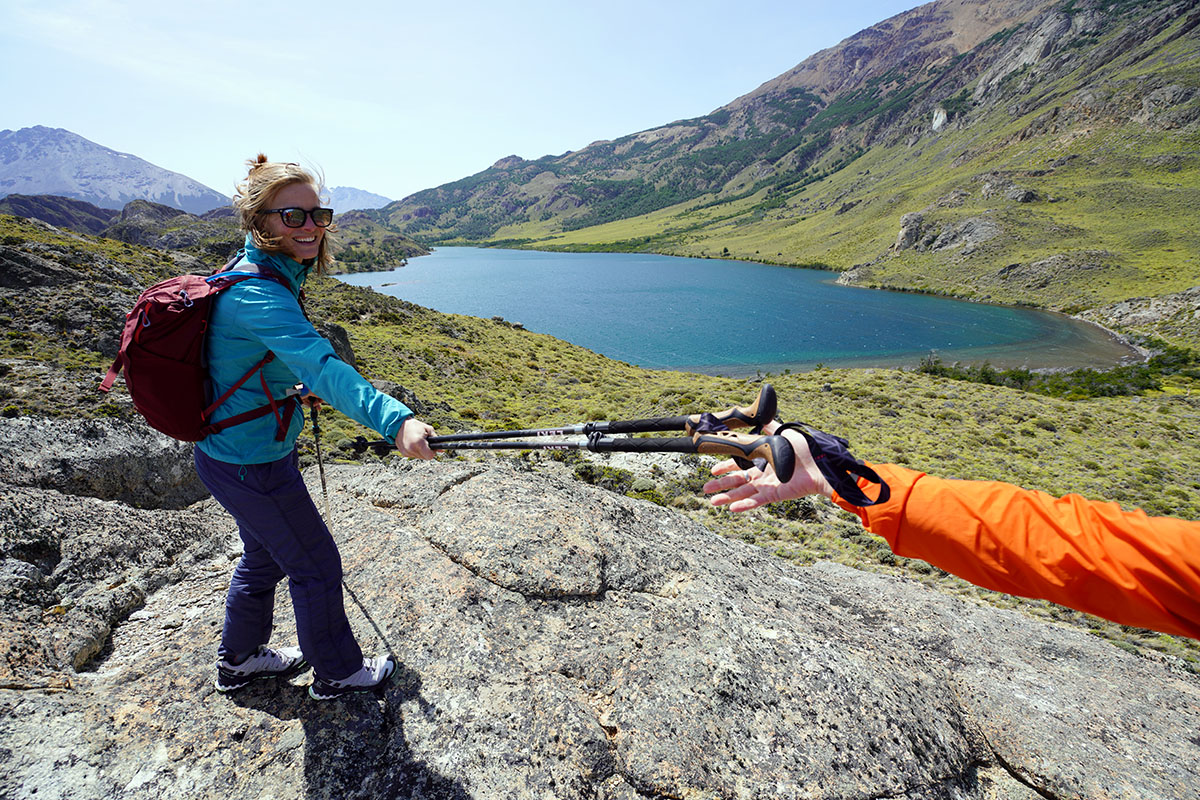
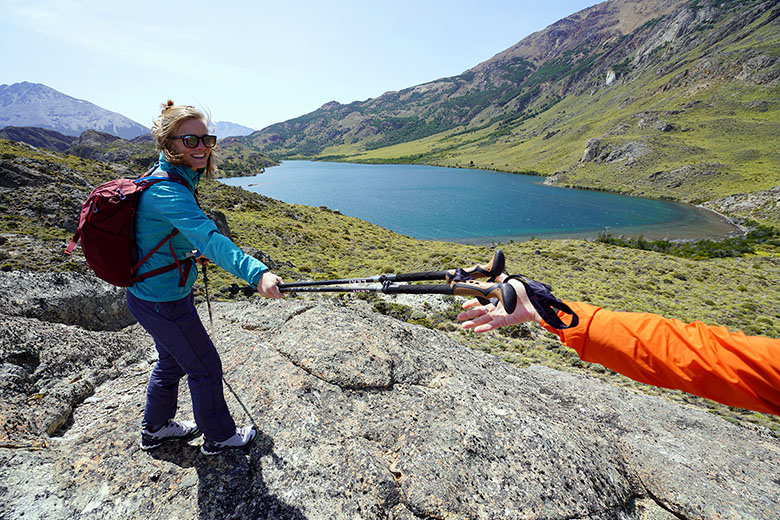
Switchback Travel


Switchback Travel
As you become a more serious hiker, the benefits of trekking poles are clear: they provide great stability while crossing loose or uneven terrain, set a nice rhythm while traveling long distances, and greatly reduce the impact on your hips, knees, and ankles. Beyond hiking, some trail runners use trekking poles for added stability, and they can even come in handy for ultralight tent setups that forgo tent poles. Regardless of your end use, our guide fills you in on what to consider when shopping for a pair of trekking poles, including styles, shaft materials, grips, length, weight, and more. For a look at our top picks, check out our article on the best trekking poles.
The first way we’ll break down trekking poles is by how they collapse, which is the most significant indication of their end use. In general, trekking poles fall into one of three categories: telescoping, folding, or fixed (non-collapsing). As we detail below, these styles offer varying levels of weight savings, durability, packability, and more.
Telescoping trekking poles are the most common style, as they are durable, easy to use, and time-tested. Popular among day hikers and backpackers alike, telescoping poles have two or three sections that slide in and out of one another and lock in place with a twist or lever-locking system. Twist locks have been around longer but are becoming less popular as they don’t offer the highest level of performance—they can get stuck if overtightened and have a tendency to loosen while on the trail. Because of this, lever locks (as seen on models like the REI Co-op Flash Carbon or the Black Diamond Trail Ergo Cork) are more reliable and popular among hikers. A big advantage to telescoping poles is that you can adjust the height as needed (such as extending your poles during downhills or for a tent set-up)—an option that isn’t available for fixed poles and many folding designs. The biggest downside to telescoping poles is that they are often heavier and don’t collapse as small as their folding counterparts.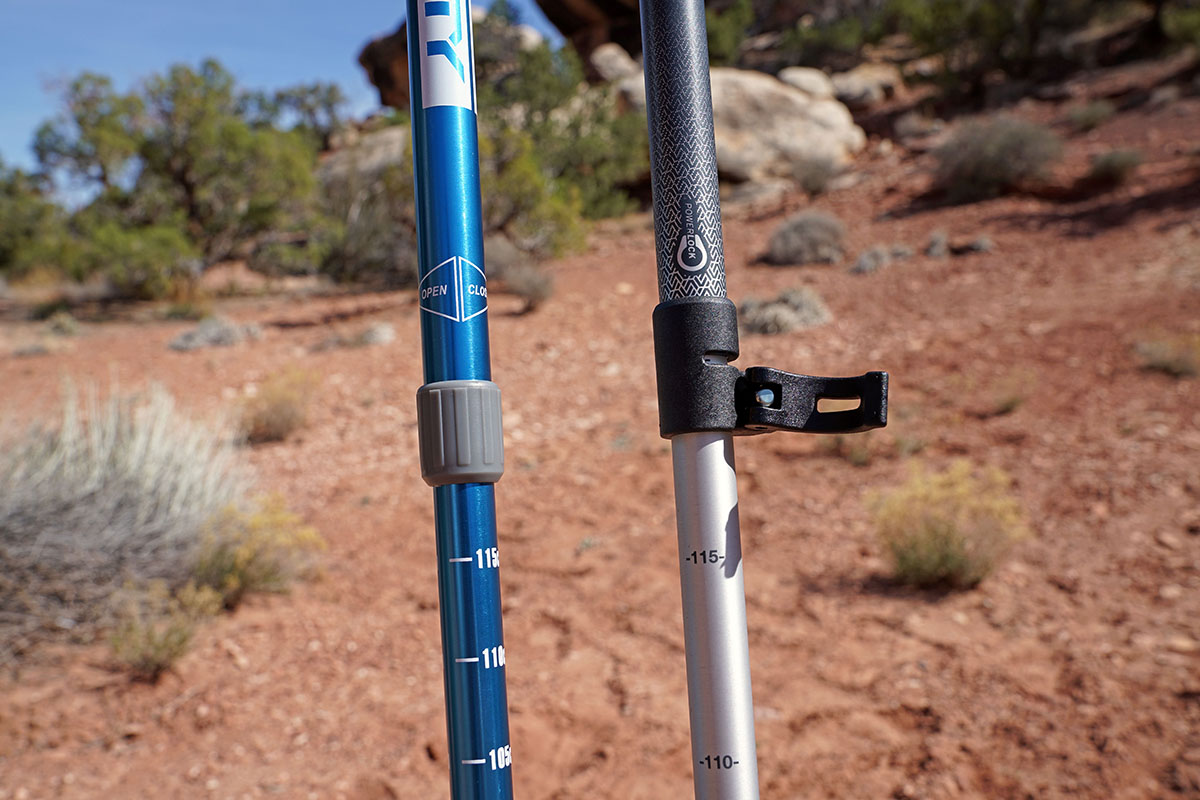
Folding trekking poles come in sections that pull apart from one another and fold up, much like tent poles. Because of this, they often have a narrow shaft which helps shed weight. They also collapse down significantly shorter than telescoping poles (some models up to 10 inches shorter), making them easy to throw in a travel bag or strap to your backpack when not in use. Because of their light weight and packability, folding trekking poles, like the Leki Micro Vario Carbon, are preferred among ultralight enthusiasts, thru-hikers, trail runners, and climbers. However, keep in mind that folding poles generally cannot bear as much weight as telescoping models and offer only a short range of adjustment. In fact, some UL models, like Black Diamond’s Z line, offer virtually no adjustment, limiting their usefulness for sharing between partners and shelter set-up.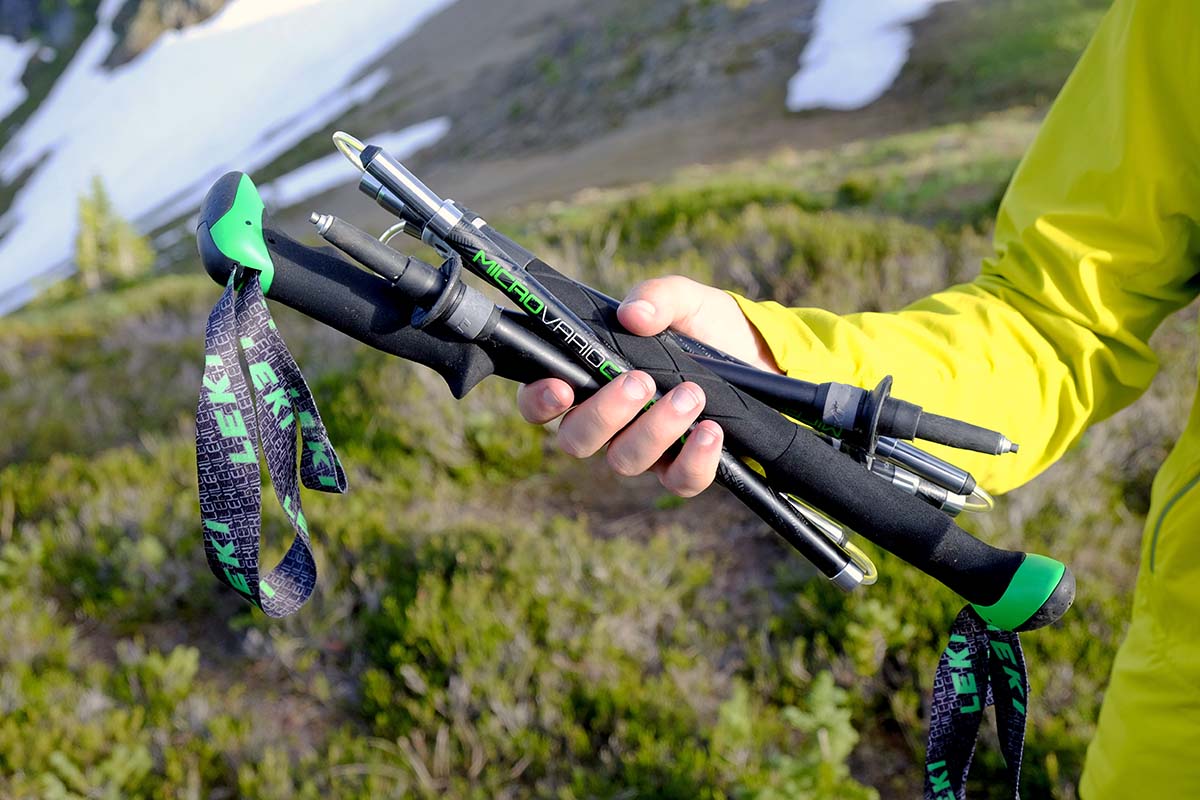
Within the hiking world, fixed poles are uncommon because they are difficult to pack or strap to a backpack when not in use. It's also nice to be able to adjust the length of your poles for up and downhill travel or when setting up a trekking pole-supported tent or shelter. However, there are still a few fixed models on the market, and because of their simplicity, they are extremely light and often cheaper than the designs mentioned above. One example is the Ultimate Direction FK, which weighs only 8 ounces for the pair. In our opinion, however, it's almost always worth opting for a telescoping or folding design.
Most trekking pole shafts are made of carbon fiber, aluminum, or a combination of the two. Carbon fiber is generally considered the better tool for the job, as it weighs significantly less and is stiffer. However, carbon has some distinct drawbacks. Most notably, carbon poles are more expensive across the board than aluminum, and they also are more brittle. When carbon is stressed, it snaps, whereas aluminum might just bend or dent (we experienced this firsthand when we accidentally sat on our carbon pole).
To consider the difference between the two materials, let's look at two designs: the Black Diamond Distance FLZ poles (aluminum) and Distance Carbon FLZ poles. The aluminum poles are $140 and weigh 15.7 ounces for the pair, while the carbon poles cost $190 and weigh 12.7 ounces. Those who prioritize shedding weight will be willing to put up with the price increase and fragility of the carbon option, while most casual hikers will opt for the durability and cost savings of the aluminum design. In the end, it's important to consider your priorities and hiking goals. 
There are three main types of materials for trekking pole grips: cork, foam, and rubber. Cork tends to be the highest-performing, as it's very comfortable and wicks sweat extremely well. We’ve also found that cork conforms nicely to the hand over time, almost like breaking in a shoe, and is an excellent shock absorber (minimizing vibration on the hands). Next in line is foam, which is another comfortable option that offers a decent amount of shock absorption. However, unlike cork, foam absorbs (rather than wicks) sweat and is not as durable or premium of a material. Finally, rubber grips are most often found on budget models like the REI Co-op Trailbreak ($60). As a grip material, rubber can be useful in wet or winter climates for shedding rain and snow, but it doesn’t offer the same comfort or sweat absorption as cork or foam. Rubber grips also tend to chafe and blister hands in warmer climates.
The shape of your trekking pole grip can add comfort or performance, but it largely comes down to a matter of personal preference. Some poles have an ergonomic shape, which is essentially a 15-degree tilt designed to match the natural resting place of the hand (we especially like those on Black Diamond’s Trail Ergo Cork). You'll also notice that many trekking pole grips are shaped to match the contours of the hand, whereas others are smoother and more uniform. In the end, it all comes down to what feels best—if the ergonomic or contoured grips feel awkward for you, you have other options (and vice versa).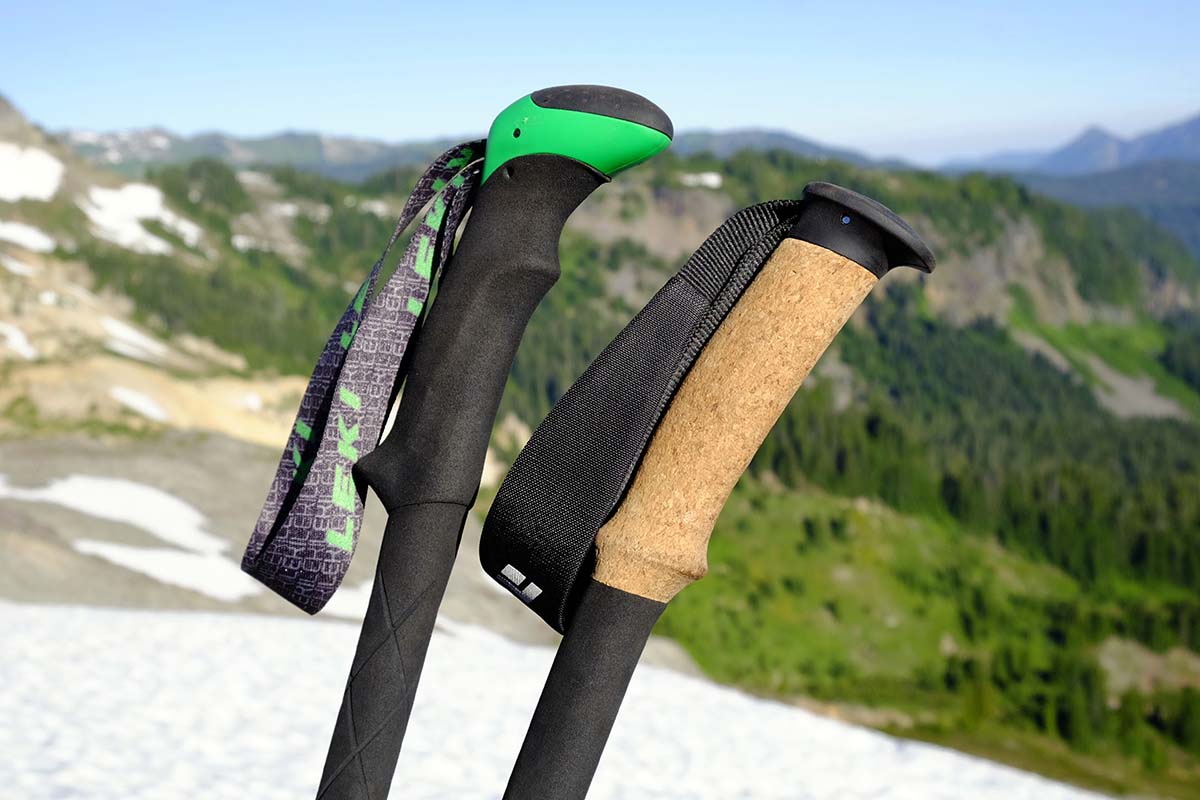
Wrist straps are another feature that can help add stability and power to your poles while requiring less squeeze from your hands. The proper way to enter wrist straps is by sliding up through the bottom, then pressing the strap into the grip with your palm. This creates a stable point of contact around your wrist, allowing you to lean onto your poles without having to death-grip the handles (most straps are adjustable too). Wrist straps are constructed out of everything from foam padding to simple nylon webbing, and we recommend trying out multiple kinds to see what feels best. If something is uncomfortable after a few strides, it will be agony 10 miles down the trail.
If you spend a lot of time covering technical, steep terrain, you'll probably benefit from a choke-up extension. This is basically a second grip just below the main grip, most often made of foam (as seen on the Leki Micro Vario Cor-Tec TA). This extra grip allows you to slide your hand down your trekking pole during steep uphills or traverses for added balance and pressing power. Some hikers even go for the DIY option of a duct tape choke-up extension.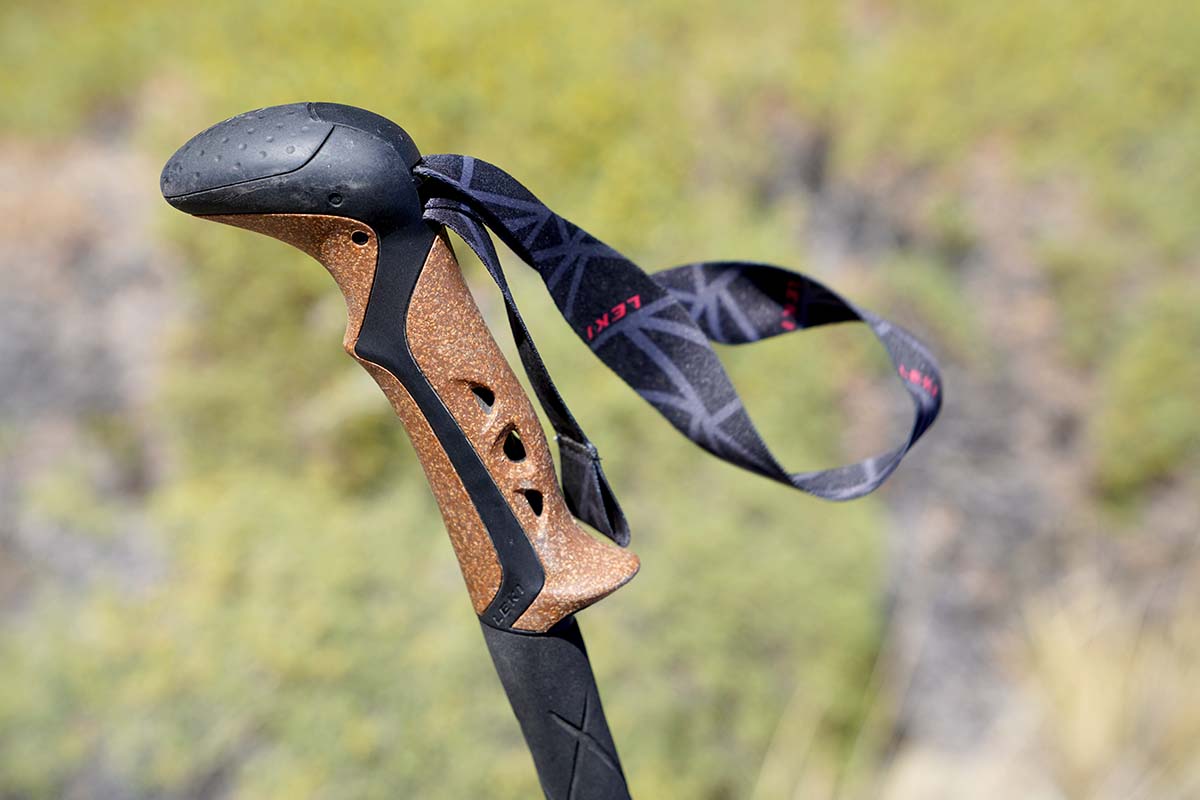
Once you determine the pole style, materials, and grips that are right for you, it’s time to consider what length of trekking pole you need. To measure your size, hold a pole (or straight stick) in your hand like you would a trekking pole, resting your arm at your side with your elbow at 90 degrees. The length from your hand to the ground will indicate your pole length. Keep in mind you’ll likely want to choke up on the pole for steep uphill sections or lengthen it on the downhill. Thankfully, most poles have at least some range of adjustment, allowing a fair amount of wiggle room for various trail needs.
Weight and packed size are two critical factors when shopping for trekking poles. In terms of weight, we’ve been amazed at how much difference just a few ounces in the hand can make on our level of fatigue, especially during long-mileage days or multi-day treks. But keep in mind that the lighter a pole is, the less durability and adjustability you can expect (and in general, the higher the price tag). For example, the telescoping, aluminum REI Traverse Power Lock poles weigh 19.5 ounces for the pair, while the fixed-length Black Diamond Distance Carbon poles tip the scales at a ridiculous 6.8 ounces (for the 120-centimeter version). Most hikers will find a happy medium somewhere in between these two extremes.
Packed size is another important factor and refers to the shortest collapsed length of the pole, whether folding, telescoping, or fixed. Not everyone will need a compact pole, but for some it's a critical consideration. Most notably, packed size becomes important particularly for travelers (who need to get the poles into a suitcase or backpack) and trail runners or hikers who put their poles away in order to cross tricky sections of trail. Folding poles have the shortest packed length (the 120mm Black Diamond Distance Z poles collapse to 16 inches), while even three-section telescoping poles (the most collapsible form of telescoping pole) are around 24 inches minimum when collapsed.
We’ve mentioned durability several times above, but there’s more to the equation than just shaft materials (carbon vs. aluminum). Manufacturers also shed ounces with thinner shafts, which is nice for ultralight hikers and trail runners but certainly more prone to damage. On the other hand, a thicker shaft will help add some stability, weight-bearing capabilities, and overall durability to your trekking poles. In general, if you want a pole that will last, we recommend an aluminum model with a fairly stout shaft (this will likely be a telescoping design) like the REI Co-op Traverse. And the good news: durable poles are generally less expensive than their lighter-weight (and more fragile) counterparts. 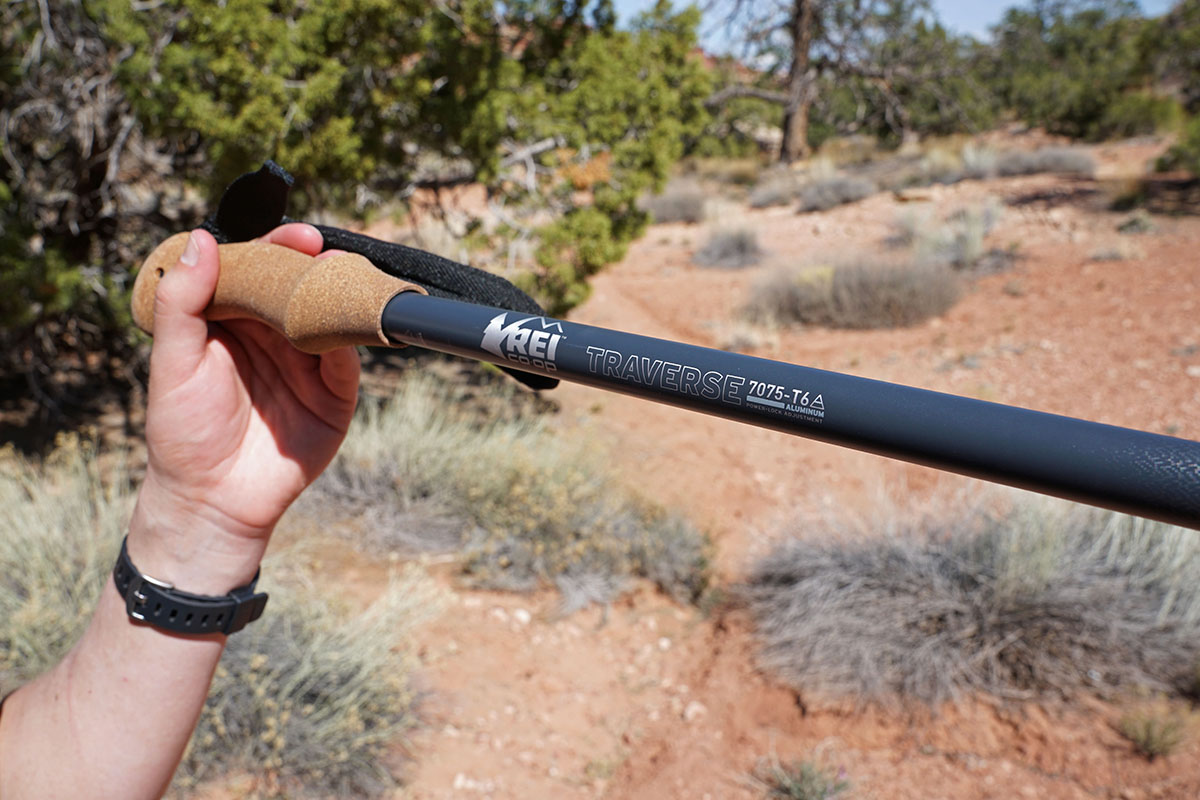
To use your trekking poles for snowy, winter hikes, or even ski touring, they must have an interchangeable powder basket at the end of the pole (not all poles have a removable basket, so shop accordingly). The wide diameter of the powder basket prevents your trekking pole from postholing, or poking through multiple feet of snowpack with little to no resistance. Many trekking poles come with powder baskets, or you can buy a pair separately (like the Black Diamond Powder Baskets) and swap them in. In addition, you’ll likely want a sturdier trekking pole for winter use (read: aluminum), especially for snowshoeing and skiing, as you tend to push off your pole with more force in the snow. And as mentioned above, rubber grips are also good for winter use as they shed water quite well, and hand feel is less of a factor when you're wearing gloves.
A handful of trekking poles on the market have built-in give that takes additional stress off of knees, as well as your wrists, on long descents. But is the added cost and weight of a shock-absorbing trekking pole worth it? In our opinion: no. In the end, all carbon and aluminum trekking poles will have some level of natural shock absorption, and we almost always opt for simplicity in the outdoors. That said, those with injuries or weak hips, knees, or ankles might be willing to pull out all the stops for a dedicated shock-absorbing model (like the Black Diamond Trail Pro Shock). 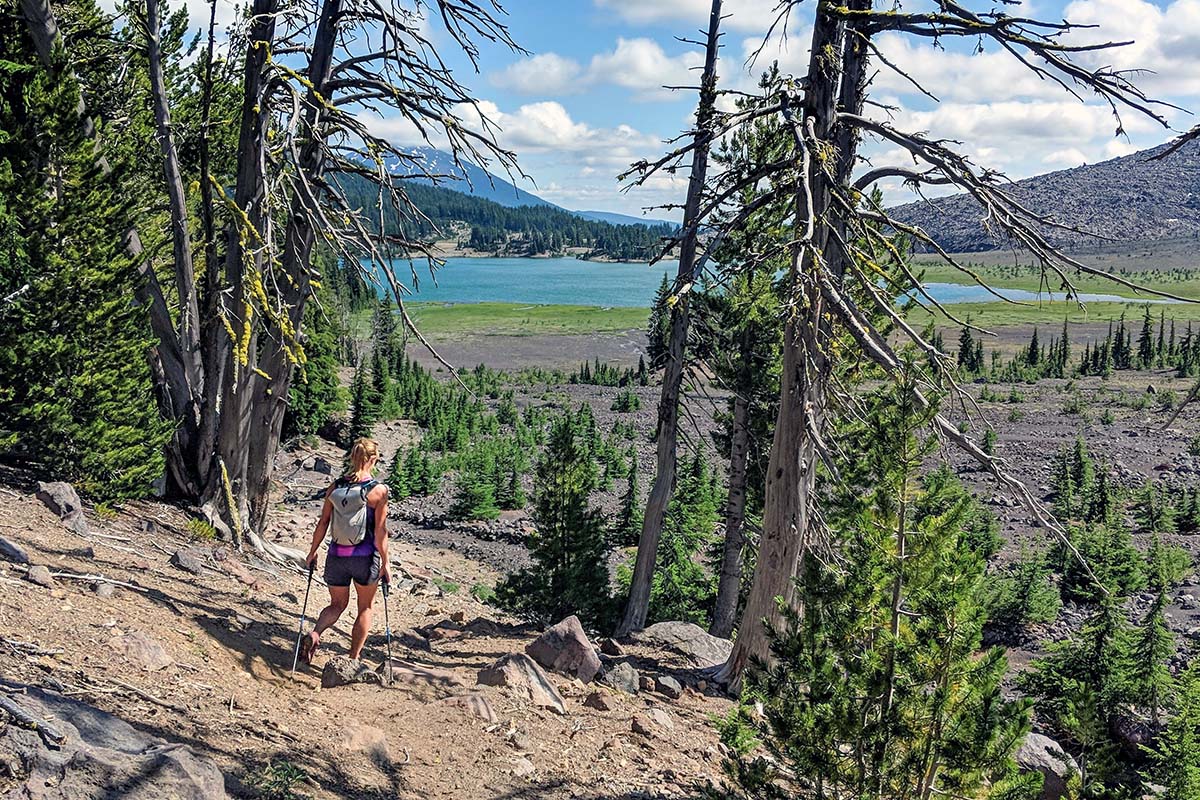
Most trekking poles are unisex, but a few brands do make designated women’s models. In general, women’s poles are built with thinner grips designed for smaller hands and have a shorter maximum length. For example, the women’s model of the REI Co-op Flash Carbon poles extends to 47 inches, while the men’s version extends to 55 inches. As a result, women’s poles also have a shorter collapsed length—up to 4 to 5 inches less in some models—making them easier to pack. In reality, any smaller hiker would benefit from a women’s trekking pole, as the grips will likely be more comfortable and the shorter size cuts weight.
Some hikers and trail runners will opt for just one trekking pole on the trail, whether it be to shave weight or free up a hand for stability on technical terrain. While hiking with one trekking pole won’t give you the same rhythm or added power as two (especially on smooth trails), it still offers more balance and stability than no pole at all. We particularly like trail running with one pole, as we generally only use it for extra support on uphill stretches (and for those purposes, one is enough). It’s important to note that the vast majority of trekking poles are sold as a pair, but a few brands sell single poles. Gossamer Gear, for example, allows you purchase a single LT5 Three Piece Carbon pole by including a note with your order.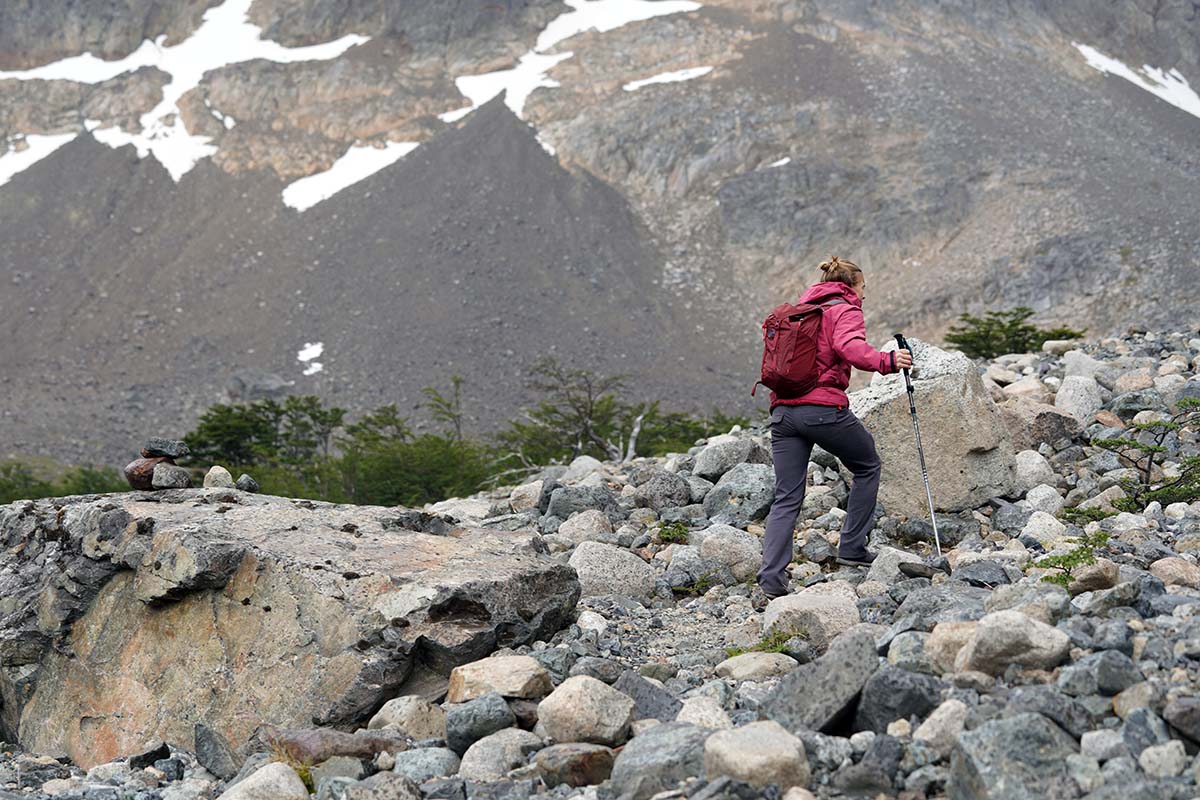
For serious ULers, trekking pole-supported shelters have become a popular way to ditch weight without compromising on space. These include models like the Hyperlite Dirigo, Zpacks Duplex, and even REI’s new Flash Air. If you opt for such a tent, you’ll want to take care in choosing your accompanying trekking poles. An adjustable pole is almost mandatory, as tents will require a specific length for setup (the Zpacks specifies a 122-centimeter trekking pole, while REI’s Flash Air requires you to collapse your pole down to 106 centimeters). Further, you’ll want to think carefully about materials—we’ve set up many shelters with carbon poles, but aluminum poles will provide a bit more assurance in strong winds.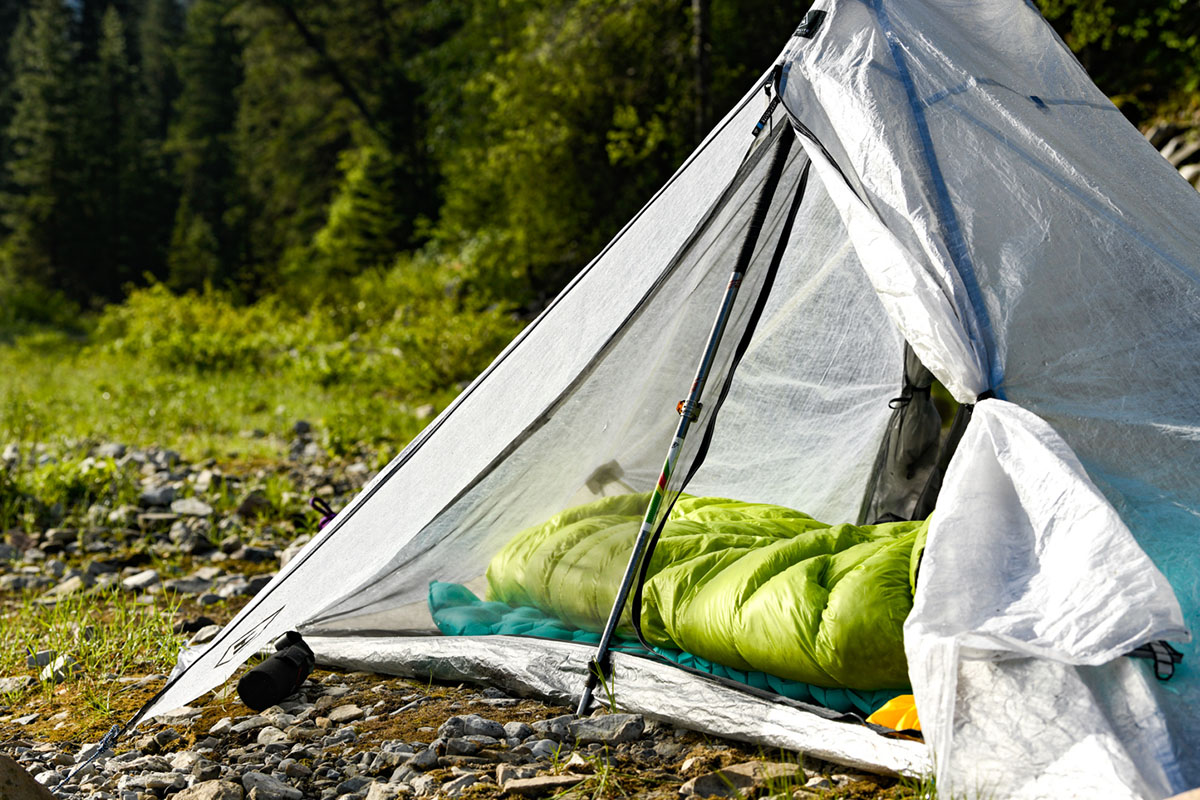
Given that trekking poles are designed to mimic the simple walking stick, it’s amazing how complex they’ve become. When shopping for a pair, there are many factors to consider, including weight, durability, collapsibility, comfort, and more. To help with the buying decision, we’ve compiled a list of the best trekking poles, and below are a few of our favorites broken down into key categories:
Best Overall Trekking Pole: Black Diamond Trail Ergo Cork
Best Budget Trekking Pole: Montem Ultra Strong
Best Collapsible Trekking Pole: Black Diamond Distance Carbon Z
Best Ultralight Trekking Pole for Thru-Hiking: Gossamer Gear LT5
See Our List of Best Trekking Poles